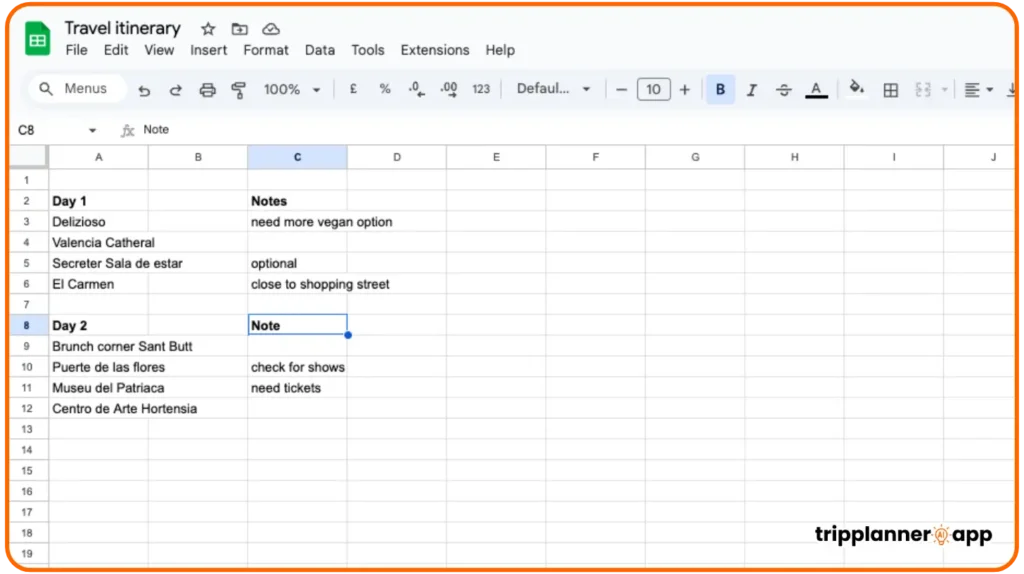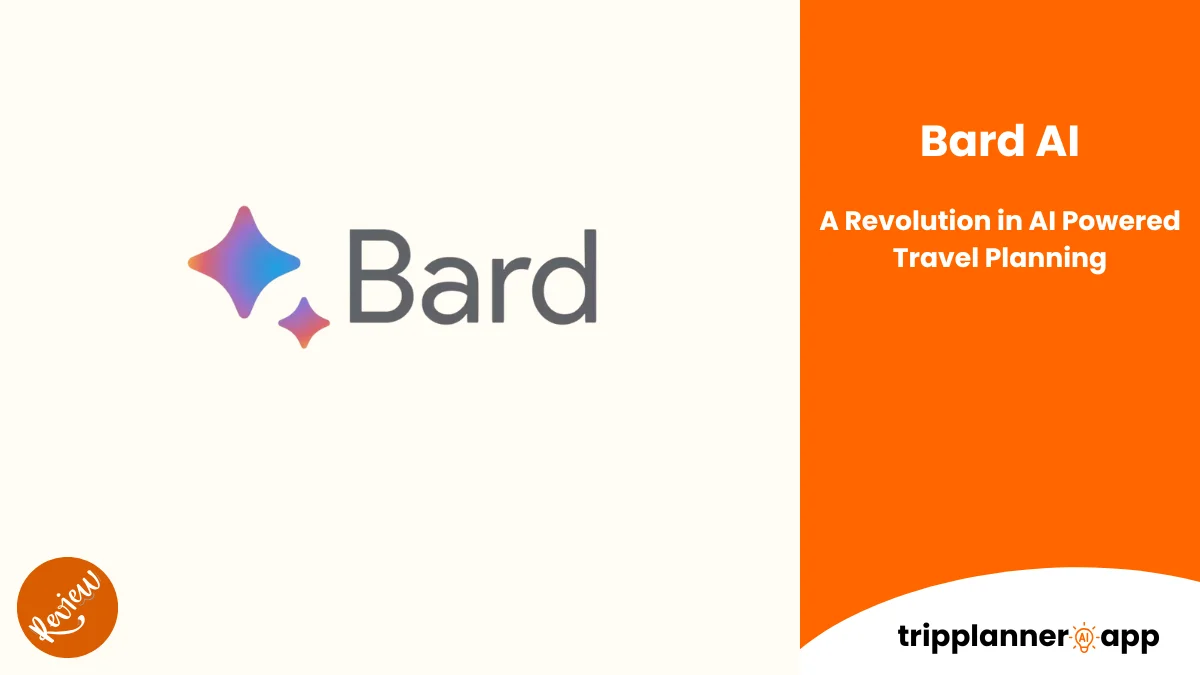Harness the power of Google Sheets to seamlessly organize and enhance your AI-generated travel itineraries, offering unparalleled flexibility and collaboration features. As an integral part of the Google Workspace ecosystem, Google Sheets brings together real-time collaboration, integration with various tools, and cost-free access, making it a preferred choice for travelers, whether solo adventurers, group organizers, or professional travel agencies.
Introduction
In today’s rapidly evolving digital landscape, Google Sheets stands out as a crucial application for organizing AI-generated trip itineraries. Its capabilities to handle complex datasets and facilitate real-time collaboration ensure that travelers can stay on top of every aspect of their journey. Whether you’re brainstorming plans with friends or adjusting travel logistics on the fly, Google Sheets provides an intuitive and versatile platform that adapts to a diverse range of travel needs.
Why Use Google Sheets for Travel Planning?
Google Sheets offers a multitude of reasons for its popularity among travelers. First and foremost, its cloud-based nature ensures that your travel documents are accessible from anywhere, requiring only an internet connection. This is particularly advantageous for travelers who are constantly on the move and need to make real-time adjustments to their itineraries. Moreover, its collaborative features allow for seamless planning with others, enabling multiple people to contribute to and edit the same document simultaneously.
Benefits of Using Google Sheets:
- Accessibility: With its file stored in the cloud, you can access and edit your travel plans from any device.
- Collaboration: Share your sheets with friends or family and work together to refine your travel plans.
- Customization: Tailor your spreadsheet to fit your specific needs with custom tables, charts, and lists.
Google Sheets excels as a universal tool for travel planning, offering outstanding flexibility and a range of features that streamline the process, making it a top choice for travelers worldwide.
How Google Sheets Supports AI Trip Planner Tools
Google Sheets seamlessly integrates with AI trip planner tools, enhancing their functionality to provide a more comprehensive travel planning experience. By converting AI-generated data into structured tables, users can organize itineraries efficiently and make informed adjustments along the way. AI tools can generate suggested activities or routes, which are best managed and modified within Google Sheets.
- Integration with AI: Google Sheets can connect with various AI platforms, automating the import of data and recommendations directly into your spreadsheet.
- Automated Updates: With AI integration, you can receive real-time travel updates and suggestions, adjusting your plans as needed.
- User Experience: AI features streamline the decision-making process, offering personalized recommendations that enhance user satisfaction.
Additionally, Sheets’ capability to utilize AI-enhanced functions allows users to perform complex data processing, such as automatic data enrichment and analytics, directly within the spreadsheet, amplifying its utility in trip planning.
Perfect for Solo Travelers, Groups, and Travel Agencies
Whether you’re a solo traveler, part of a group trip, or managing trips for a travel agency, Google Sheets offers features that cater to your specific needs. For solo travelers, it provides a structured way to keep track of personal itineraries and ensures that every aspect of the trip is accounted for. Groups benefit from its collaborative nature, where multiple participants can suggest activities and vote on preferences directly in the sheet.
Advantages for Different Traveler Types:
- Solo Travelers: Keep all your travel logistics in one place, modify plans on the go, and use built-in budgeting tools to monitor expenses.
- Groups: Shared access allows everyone to chip in, facilitating smoother coordination and reducing last-minute changes.
- Agencies: Manage clientele itineraries with custom templates, ensuring each itinerary is tailored to client preferences.
Thus, Google Sheets serves as a multifaceted tool that fits a variety of users, helping create well-rounded travel plans that are efficient and enjoyable for everyone involved.
Key Features for Trip Itinerary Management
Google Sheets offers a robust set of features that make trip itinerary management efficient and comprehensive. By leveraging its cloud-based platform, users can enjoy real-time collaboration and a high level of customization that meets the diverse needs of travelers.
Cloud-Based, Real-Time Collaboration
Google Sheets’ cloud-based system is one of its most powerful features for trip itinerary management. This setup allows for real-time collaboration, a must-have for travelers planning group trips or coordinating business travel. Multiple users can access and edit the same document simultaneously, ensuring everyone remains on the same page regardless of where they are in the world.
- Remote Teamwork: Ideal for group travel planning, allowing co-travelers to make contributions simultaneously.
- Instant Updates: Changes reflect immediately, reducing the chance of miscommunication and outdated information.
- Access Anywhere: Travelers can update itineraries on the go from any device without the hassle of file transfers.
Google Sheets’ cloud-based functionality makes it unparalleled in terms of accessibility and collaboration, marking it as a key player in efficient trip itinerary management.
Customizable Tables, Checklists, and Budgets
Customizability is a hallmark of Google Sheets, particularly when managing trip itineraries. It allows users to create tailor-made tables, invaluable for organizing travel plans into digestible and actionable formats. Whether you’re detailing a day-by-day itinerary, tracking packing lists, or setting up a budget, customization reigns supreme.
- Itinerary Tables: Use custom columns for dates, times, activities, and necessary notes. Adjust these elements as you map out your journey.
- Checklists: For packing or pre-trip to-dos, checklists are easily incorporated and can be checked off as each task is completed.
- Budget Sheets: Built-in formulas are helpful for tracking expenses against your budget, pivoting on fluctuating financial circumstances as needed.
These customizable elements provide travelers with the structure needed to ensure every aspect of the trip runs seamlessly. They offer adaptability that precedes and accommodates any last-minute adjustments, making trip management stress-free.
Built-In Functions for Cost Tracking and Planning
Financial management is integral to successful travel planning, and Google Sheets shines in this regard with its built-in functions. These functions allow for meticulous cost tracking and provide real-time insights into budget adherence.
- Formulas and Functions: Utilize functions like SUM, AVERAGE, or COUNTIF to dynamically calculate travel expenses.
- Automatic Updates: As costs are logged, total expenditures update instantly, giving you an accurate financial picture.
- Scenario Analysis: With Sheets, simulate budgetary impacts of modifications, such as adding excursions, ensuring you stay within financial limits.
A major advantage is the ability to visualize spending through graphs and charts, which can be easily created using the Sheets UI. This aids in practical financial oversight and enables informed decision-making throughout your travel planning process.
Conditional Formatting for Prioritizing Activities
Creating a balanced itinerary is crucial, and conditional formatting in Google Sheets serves as an excellent tool for prioritizing activities based on criteria such as urgency or interest. This feature allows for color-coding of cells, serving as visual indicators to help distinguish between various tasks or engagements.
- Visual Cues: Assign colors to activities based on priority or completion, ensuring immediate visibility of key items.
- Prioritization: Highlight critical items such as flight departures in bold or different tones to differentiate importance.
- Efficiency: Quickly determine which aspects of your itinerary require the most attention, greatly enhancing planning efficiency.
Through conditional formatting, travelers can maintain focus on important components, ensuring nothing falls through the cracks during preparation and execution phases of their trips.
Integration with Google Maps, Calendar, and Docs
Google Sheets pairs beautifully with other Google services such as Maps, Calendar, and Docs, creating a dynamic and interconnected planning environment. Synchronizing these tools with Sheets extends its functionality and aids in comprehensive travel planning.
- Maps Integration: Embed directions and estimated travel times directly in your itinerary, mitigating logistical surprises.
- Calendar Sync: Link plans with Google Calendar to receive reminders and avoid overbooked schedules.
- Docs Collaboration: Attach detailed plans, tickets, or additional notes via Google Docs, ensuring all necessary information is effortlessly accessible.
These integrations highlight the seamless nature of Google’s ecosystem, which supports efficient and holistic trip planning across its suite of tools.
Read reviews of other AI trip planners and support tools to help you plan smarter.
EasyTrip AI: Transform Travel Planning with Personalized Itineraries
EasyTrip AI is reshaping the future of travel planning with its sophisticated AI-powered itinerary planning capabilities. In a world where personalized experiences are valued over standard travel packages, EasyTrip AI [...]
How Google Sheets Enhances AI-Generated Itineraries
With enhancements provided by key features, Google Sheets transforms AI-generated itineraries into structured, editable documents that allow users to take an active role in customization and refinement.
Structuring AI-Suggested Itineraries into Editable Tables
AI-generated itineraries often provide a blueprint for travels Google Sheets enables users to structure these initial plans into comprehensive and editable tables. This translates raw AI data into personalized trip schedules through an easy-to-navigate interface.
- Table Setup: Initiate columns for essentials like ‘Date’, ‘Activity’, ‘Location’, and ‘Notes’ to develop a robust framework for your trip.
- Fine-Tuning: Adjust suggestions based on personal preferences or constraints, giving the itinerary a personalized touch.
- Optimization: Leverage tables for bulk edits or filtering to compare different aspects of your plan for maximum efficiency.
By effectively restructuring AI suggestions, Google Sheets helps users create a functional itinerary tailored to specific needs and desires.
Adding Personal Notes, Adjustments, and Day-by-Day Plans
Customization is straightforward in Google Sheets, and users can enhance their AI-generated itineraries by incorporating personal notes and adjustments. This process ensures the itinerary reflects personal style and travel goals.
- Comments and Notes: Annotate plans with additional thoughts or reminders, keeping them top-of-mind when needed.
- Day-by-Day Personalization: Detail each day’s agenda, accounting for transit times, activities, and leisure moments.
- Flexibility and Updates: Modify itineraries at will, accommodating for new insights or spontaneous changes in travel plans.
This capacity for customization is invaluable, allowing an amalgamation of AI recommendations with personal and dynamic trip details.
Comparing Multiple AI Itineraries Side-by-Side
A distinctive benefit of using Google Sheets is the ability to compare multiple AI-generated itineraries side-by-side, facilitating insightful decision-making for your travel journey.
- Comparison Tables: Set up multiple columns to juxtapose itineraries, comparing elements like travel time, costs, or key attractions.
- Decision Metrics: Utilize insights from side-by-side analysis to craft a final itinerary that aligns with your objectives.
- Flexible Evaluation: Shuffle activities between plans or merge the best elements to form a superior travel agenda.
This comprehensive comparison capability empowers users to make informed choices about their travel plans, optimizing for both efficiency and enjoyment.
Storing Research Links, Booking Info, and Local Tips
Effective travel requires information collation, and Google Sheets serves as a repository for research links, booking details, and local insights. This function consolidates critical data in one accessible location.
- Hyperlinking: Use links to centralize information on attractions, accommodation options, and locals’ recommendations.
- Booking Management: Organize reservation details into dedicated sections, with real-time edit capabilities ensuring accuracy.
- Insider Information: Log tips and recommendations from locals, enriching travel plans with authentic experiences.
This centralized approach streamlines the planning process by ensuring all travel-related details are organized and ready to access at any time.
Real Travel Use Cases
Real-world applications demonstrate Google Sheets’ versatility in enhancing AI-generated itineraries, offering a detailed look into practical use and benefits in collaborative travel planning scenarios.
Shared Sheets for Group Itinerary Collaboration
One of Google Sheets’ standout uses is facilitating group travel planning through shared sheets. This feature lets travel companions collaborate efficiently by contributing and editing the itinerary in real time.
- Shared Access: Assign editing permissions to all group members, enabling everyone’s input without losing control over final decisions.
- Role Definition: Designate sections for specific responsibilities, such as managing budget or organizing activities, enhancing coordination.
- Dynamic Editing: Benefits from collective brainstorming, merging ideas for a cohesive travel plan reflecting diverse preferences.
The collaboration enriches the travel planning experience, prioritizing both inclusivity and ease.
Travel Expense Trackers by Category and Traveler
Managing travel expenses is simpler with Google Sheets, which facilitates detailed tracking by category and traveler. This clarifies finances, providing peace of mind and transparency in shared trips.
- Expense Categories: Classify costs under transport, accommodation, meals, and entertainment for precise tracking.
- Individual Records: Allow each traveler to maintain their expense column, simplifying cost-sharing at the trip’s end.
- Clear Summaries: Automatically calculate subtotals and totals, ensuring clarity and budgeting accuracy at every trip stage.
Google Sheets transforms expense handling, aligning with cost-consciousness and emphasizing accountability in travel spending.
Packing Lists and Pre-Trip To-Dos
Google Sheets user-friendly interface aids in creating thorough packing lists and pre-departure checklists, ensuring no detail is overlooked.
- Packing Categories: Organize lists into categories like mandatory, optional, or contingency items, enhancing checklist efficacy.
- Pre-Trip Planning: Record vital preparations such as travel insurance, reservations confirmations, and health checks.
- Automated Checking: Use checkboxes in Sheets to mark off completed tasks, facilitating stress-free, organized preparations.
Packing lists ensure essential items accompany travelers, while pre-trip to-dos lessen departure-day chaos.
Timeline Grids with Departure, Arrival, Check-In Info
Creating detailed timeline grids departures, arrivals, and check-ins provides clarity and helps travelers manage their journey’s logistics.
- Grid Structure: Use rows for dates spanning from preparation to arrival and label columns with each day’s key tasks.
- Travel Milestones: Simple, color-coded grids help track flights, check-ins, and time zone changes, maintaining awareness of upcoming commitments.
- Interactive Elements: Comment on each cell, noting any specific adjustments, ensuring easy updates as plans evolve.
Using timeline grids, Google Sheets demystifies travel timelines, facilitating better-prepared, smoother travel days.
Integration with Other Tools
Google Sheets’ integration capabilities complement its uses in managing AI-generated itineraries, ensuring that users can easily transition between applications and maintain a cohesive planning approach.
Exporting from AI Tools to CSV/Google Sheets
Exporting data from AI tools into CSV or Google Sheets is a straightforward process, assisting in managing and updating itinerary information.
- CSV Conversion: Use standard export procedures to convert AI outputs into CSV files compatible with Google Sheets.
- Data Synchronization: Ensure seamless import of CSV data into Sheets, allowing for real-time updates and easier manipulation.
- AI Tool Compatibility: Sheets supports various export features from AI platforms, improving data management processes.
These export functions bootstraps travel planning by simplifying data migration into accessible document formats.
Embedding Google Maps Links and Calendar Events
Embedding geographical data into Google Sheets with Google Maps links or syncing schedules with Calendar events optimizes travel coordination.
- Location Embedding: Integrate Google Maps links for ease of navigation, effortlessly guiding travelers from place to place.
- Schedule Synergy: Sync Sheets with Calendar for reminders and time management, synchronizing crucial activities with time blocks.
- Enhanced Visualization: Visual documentation supports coordination, reducing scheduling errors and ensuring a smooth itinerary execution.
These integrations elevate Google Sheets from a mere planning tool to a comprehensive travel management solution.
Syncing with Google Docs or Trip Dashboard
Collaboration across Google’s ecosystem creates a fluid planning experience, where information flows seamlessly between Sheets, Docs, and dashboards.
- Document Uploading: Directly attach Google Docs to Sheets for shared access, linking itineraries with deeper insights or travel notes.
- Trip Dashboard: Use Sheets as a central dashboard, connecting with various Google Services for holistic oversight.
- Cross-platform Collaboration: Allows collective planning through distinctly formatted tools, ensuring clear communication across the planning team.
Leveraging Google’s platform synergy ensures well-rounded integration, making travel preparations both efficient and engaging.
Using Sheets as Backend for Notion or Web-Based Itinerary Pages
Employing Google Sheets as a database for Notion or web-based trip pages offers technical advantages in customization and data backup.
- Sync Features: Utilize sync tools to maintain data accuracy between Sheets and web applications, ensuring consistency in plans.
- Backend Analysis: Google Sheets as a backend offers robust testimonial data handling, leveraging spreadsheets for intricate computation.
- Interactive Dashboard: Create user-friendly interfaces on public sites while maintaining core data in Sheets, enabling visitors to explore planned trips interactively.
Google Sheets transforms functionality, combining intuitiveness with technical prowess for enriched content delivery solutions.
Pros and Limitations
Exploring Google Sheets’ integrations reiterates its versatile role in trip planning, characterized by certain advantages alongside identifiable constraints. Understanding its full potential provides perspective on how its use can be optimized to meet various demands.
Pros: Free, Flexible, Widely Used, Cross-Device Compatible
Enabled through its fundamental design, Google Sheets’ pros illustrate why many turn to it as their primary tool for planning.
- Free Access: Promotes adoption without licensing or subscription costs, making it ideal for individuals or businesses not seeking additional expenses.
- Flexible Customization: Offers adjustable templates and features, enhancing creativity and freedom in structuring content as per travel demands.
- Wide Usage: As part of Google’s ecosystem, it benefits from familiarity and consistent interface design encouraging collaborative travels.
- Universal Accessibility: Cloud-based nature facilitates cross-device compatibility, granting access irrespective of geographic location or device constraints.
In essence, Google Sheets provides a widely utilized resource that offers significant value in terms of flexibility and financial savings.
Limitations: Manual Setup Required Unless Integrated
While lauded for its freeform design and flexibility, certain inherent limitations may restrict usability in specific contexts.
- Manual Configuration: Advanced customization requires manual scripting or third-party setups, demanding technical acumen or time.
- Limitations in Automation: Lacks depth without external tools; some automated tasks like frequent real-time data integration or alerts require additional extensions.
- Formatting Constraints: Provides less sophisticated formatting options compared to purpose-built software, affecting complex layout demands.
Navigating Google Sheets’ limitations alongside its abundant features guides users to find potential overlaps with additional applications, working optimally under integrated conditions.
Best for People Who Want High Control and Customization
Google Sheets is perfect for travelers motivated by high levels of personalization and control, leveraging adaptability to meet exact specifications.
- DIY Approach: Empowers users with tools to individually refine and tailor functionalities without strict rigidities.
- Control Over Layout: Choose bespoke templates and extensive data manipulation features for comprehensive itinerary creation.
- Adaptable Plans: Modify structures without vendor-specific limitations, customizing every detail to precise user standards.
Such flexibility presents Google Sheets as an appealing option for those concentrated on personal touches, preferring to shape their journey down to the last mile.
Tips for Using Google Sheets in Trip Planning
Harnessing the full potential of Google Sheets simplifies travel plan assembly, informed by both features inherent to the system and strategic considerations for trip construction.
Use Templates for Fast Setup (Budget, Itinerary, Checklist)
Templates embedded within Google Sheets offer convenient starting points, minimizing groundwork time while guaranteeing thorough document assembly.
- Template Selection: Access free trip planning templates covering diverse needs like budgets, packing lists, and intended routes.
- Tailoring Features: Customize pre-made templates, imbibing unique trip characteristics or standards as required.
- Rapid Deployment: Deploy templates for quick and reliable layout initiation, expediting groundwork construction for busy travelers.
Choosing templates fulfills setup demands, fast-tracking process initiation and simplifying companion data input.
Protect Ranges When Sharing with Groups
Prioritizing data security involves elevating specific cell protections in collaborative spaces to growing attack risks or missteps.
- Range Protections: Lock sensitive areas, like budget totals, ensuring integrity while broadening access permissions.
- Security Enhancements: Distribute access without fear of overwriting, maintaining structure as various travelers contribute their perspectives.
- Editing Restrictions: Configure shareable sheets with export-only rights where necessary, reducing external modifications.
This approach ensures safeguarding delicate traveler-oriented data while encouraging collaborative sharing.
Use Data Validation to Avoid Errors
Implementing data validation promotes accuracy in collective travel documentation, indispensable for coherent data structure and confrontation mitigation.
- Validation Rules: Establish dropdown options like dates or destinations, ensuring consistency among shared fields.
- Error Control: Prohibit incorrect data, directing users to standardized entries or automatic corrections for non-compliance detection.
- Seamless Coordination: Guide participants through reliable settings, promoting unity in complex content building.
Data validation ensures input standardization, crucial for amalgamating inputs from various sources into one cohesive format.
Keep a Separate Sheet for Backup and Versioning
Maintaining backups consolidates security, providing restoration points throughout planning and reducing possible oversight risks.
- Union Storage: Use Sheets’ extensive versioning capacity to pinpoint past instances, allowing rapid return to specific states.
- Version Control: Record major revisions through historical markup or manual entries, preserving progress and clarity.
- Mistake Buffering: Present rollback assurances against errors, minimizing disruptions with reliable, continuous development tracking.
Using backups offers value in documenting processes, affording travelers safety as they prepare leisurely pursuits.
Final Thoughts
Overall, Google Sheets proves indispensable as a resource for building AI-generated itineraries, demonstrating range and efficacy across multiple scenarios. Whether planning solo or with others, Sheets’ flexibility and connectivity broadens strategic thinking, supporting informed decision-making. By integrating with AI tools, automated scheduling, and cross-platform cooperation, Google Sheets accommodates broad travel necessities, serving both managers and adventurers alike. The suite’s simplicity parallels its profound complexity, bridged through intuitive additions that meet travelers’ dynamic requirements.
Google Sheets excels as an organizational ally, transforming abstract plans into coherent, actionable trips while allowing automation for repeated tasks. Retaining control while making intelligent suggestions reflects personal nuances of organized travel. By utilizing Sheets for planning vacations or work engagements, travelers can construct multi-layered journeys successfully.
Still Looking for the Perfect AI Trip Planner?
Discover all the best AI-powered trip planning tools in one place. Whether you need a fast itinerary builder, a chat-based assistant, or a browser extension — we’ve got you covered!
Browse All AI Trip Planners





